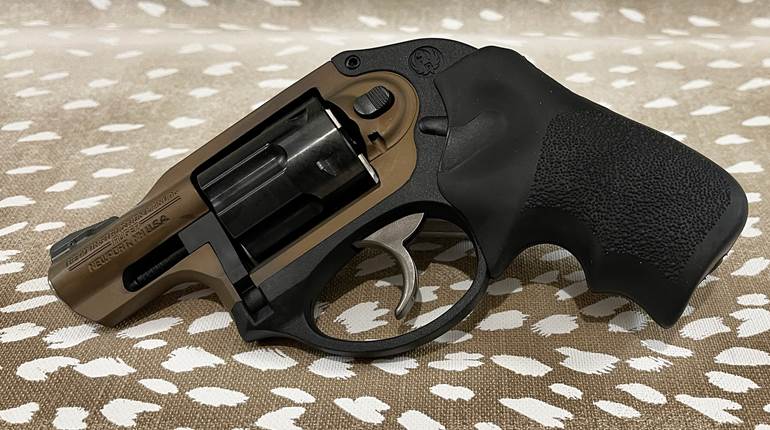
The sport of cowboy action shooting was on fire in the early 1990s. Said by some to be a hundred years too late, the sport was born in the 1980s in southern California and features 19th century firearms or replicas in a timed three-gun shooting match. The Colt Single Action Army revolver—or replicas thereof—has been the hands-down favorite for these contests. At least that was the case until 1993 when Ruger brought out its wildly famous Blackhawk single action in a fixed-sight version, christened the Vaquero.
When it was first introduced the Vaquero was made on the same size frame as the Super Blackhawk. Big, beefy and almost indestructible, the first Vaqueros were chambered in .45 Colt. These revolvers were capable of withstanding the “Ruger” loads intended to turn the .45 Colt into an ersatz .44 Mag. with heavy dollops of H110 or Winchester 296 powders behind bullets as heavy as 325 grains, but cowboy action shooters want much milder loads for their game. The very first Vaqueros featured 7 1/2-inch barrels and frames with a faux color casehardening, and barrels and cylinders were blued. Grip panels were of plain, straight-grain walnut with the Ruger logo medallion embedded in each panel. In 1998 some Vaqueros were being shipped with faux ivory grip panels.
Vaqueros met with instant success, and soon Ruger began offering 5 1/2- and 4 5/8-inch barrels to stay in step with the original Colts of the latter 19th century. It wasn’t too long before Ruger offered the Vaquero in bright stainless steel and chamberings like .357 Mag., .44-40 WCF and .44 Mag.
The Vaquero utilized the same transfer bar system developed for earlier Blackhawk revolvers. This system allowed the revolver to be carried with all six chambers loaded since the hammer could not touch the rear of the firing pin unless the trigger was completely pulled. Another perceived advantage of this system was that the hammer no longer needed to be pulled to half-cock in order for the cylinder to be manually rotated for loading and unloading. Simply open the loading gate, and the cylinder rotates freely.
In 1999, Davidson’s, the Arizona-based gun distributor, ordered a special run of 500 each in stainless steel and blued, with a color casehardened frame and a 3 3/4-inch barrel chambered in .357 Mag. and .45 Colt. Called the Sheriff’s Model, collectors have long since grabbed these up, and if you find one for sale, be prepared to give up some significant cash.
A year after the Sheriff’s Model, the San Diego Sheriff’s Association contracted for a limited run of approximately 1,000 chambered in .40 S&W and embossed on the barrel was the association’s logo to commemorate the association’s 150th anniversary. It is reputed that about 125 copies of this revolver, sans the sheriff association’s logo, were released to the public because of an overrun. Some 25 to 30 of these revolvers had the infamous user warning on the underside of the barrel instead of the side. Ruger collectors swoon over these examples.
Three grip variations are seen in the Vaquero: the standard, which emulated the Colt SAA grip profile, the Bisley, mimicking the target variation seen on the Colt and the Birdshead (in the catalog line for the year 2001 only), a profile seen on the 1887 and 1888 models offered by Colt.
In 2005 Ruger introduced a smaller frame in its Blackhawk and Vaquero lines that very closely replicates the original Colt SAA profile. Christened the New Model Vaquero—and sometimes referred to as the .357 frame model—the new guns are more like the original Blackhawk line, albeit with the transfer bar ignition system. The grip frame so closely matches the original SAA that two-piece grip panels made for the Colt will fit the New Model Rugers with minimal fitting. The New Model Vaquero also featured a beveled front on the cylinder to ease reholstering the revolver without scraping off bits of the holster. Grip panels on the New Model Vaqueros are of black plastic mimicking the old hard rubber grips of the Colt.
Another variation, the Montado, which features a 3 3/4-inch barrel and a lowered hammer spur for ease of cocking became available targeting the mounted cowboy action shooter who shoots balloons from a running horse with black-powder blanks. It, too, has found favor not only among mounted shooters but traditional cowboy action shooters as well.
But the Vaquero has expanded its market beyond the folks who like to dress up and play cowboy on the weekends. Ruger’s reputation for bulldog-tough revolvers and value for the money has made the Vaquero a favorite of many backwoods travelers who need a rugged and reliable pistol to deal with come what may. These are the people who don’t care about pinpoint accuracy but who do have a need for a handgun that will shoot minute of bear or minute of bandit should the need arise. They don’t want or need a gun that requires the additional care an adjustable-sight revolver does. They want a simple, less-expensive piece that they will have on them constantly, ready for action and not fussing for attention. The Vaquero fills that bill splendidly.
Ruger—or its distributors—has offered engraved Vaqueros, as well as matched pairs with consecutive serial numbers from time to time. These special runs are naturally sought after with zeal by Ruger collectors, making them beyond the reach of much of Ruger’s traditional market—shooters.
My own pair of New Model Vaqueros have been with me for about a half dozen years. Chambered in .357 Mag., they have withstood everything from black powder handloads to my .357 thumper loads and never hiccupped. I gave a brief thought of selling them after I switched to a matched pair of Colts in .44-40 WCF, but more and more I found myself gravitating toward them when I wanted some casual plinking or playing trick shooter. They are also seeing more time with me in my truck when I’m out for a day of photography or simply loafing on the desert surrounding my home. They are light, easy to pack, accurate and tough enough to handle anything I might care to dish out upon them. They are, in fact, vaqueros.






































